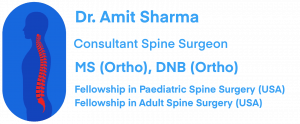Best Spine Surgeon in Mumbai | Dr. Amit Sharma

+91-9967600461
draks777@gmail.com
What is minimally invasive spine surgery!

What is minimally invasive spine surgery!
Minimally Invasive Spine Surgery in Mumbai
Introduction
Minimally Invasive Spine (MIS) surgery has revolutionized the field of spinal treatments by offering effective solutions with minimal collateral damage to surrounding tissues. This article explores the advantages of MIS and its significance in both decompression and instrumentation surgeries. We’ll delve into the importance of microscopic and endoscopic techniques for decompression, as well as spine navigation and robotics for instrumentation.
Minimally Invasive Spine Surgery for Decompression
Microscopic and Endoscopic Techniques
Minimally Invasive Spine Surgery for decompression involves specialized tools such as microscopes and endoscopes, providing spine specialists with magnification and illumination. The most common procedure in MIS surgery is micro-endoscopic discectomy. This technique employs tubes or endoscopes to delicately remove herniated spinal disc portions that compress the spinal cord or nerves. Similarly, lumbar canal stenosis, characterized by the compression of the spinal cord due to overgrown bone, ligaments, or disc material, can be effectively treated with minimally invasive procedures.
Advantages of Decompression with MIS
The advantages of decompression using MIS are multifold. Patients experience quicker post-operative recovery, minimal blood loss, reduced pain medication requirements, faster return to normal activities, and a cosmetically acceptable minimal scar on the skin. The use of specialized equipment ensures safety and effectiveness in decompression procedures, making MIS a preferred choice over conventional spine surgeries.
Minimally Invasive Spine Surgery for Instrumentation
Spine Navigation and Robotics
Traditionally, extensive muscle dissection was necessary for passing screws during spine instrumentation surgeries. However, MIS surgery has introduced advanced techniques such as spine navigation and robotics to streamline the process. Through a one-centimeter incision, screws are precisely placed, and multiple holes are made for their insertion. Specialized instruments and advanced training are crucial for spine doctors to master these techniques. Additionally, intra-operative x-ray machines (c-arm), computer navigation, and spine robots play pivotal roles in enhancing the accuracy and efficiency of minimally invasive spine surgery for instrumentation.
Advantages of Instrumentation with MIS
Minimally invasive spine surgery for instrumentation offers several advantages over traditional methods. Patients benefit from reduced muscle dissection, leading to faster recovery and less post-operative pain. The use of advanced technologies ensures the precise placement of screws, enhancing the safety and effectiveness of the procedure. Furthermore, the smaller incisions contribute to a cosmetically pleasing outcome.
Some other procedures like cementing (vertebroplasty/ kyphoplasty) also can be done using minimally invasive spine surgery techniques to take care of spine fracture.
Conclusion:
The evolution of minimally invasive spine surgery has significantly transformed the landscape of spinal treatments. Whether for decompression or instrumentation, MIS techniques utilizing microscopic, endoscopic, navigation, and robotic technologies offer patients faster recovery, reduced pain, and cosmetically acceptable results. As spine specialists continue to embrace these advancements, the future of spinal surgeries appears to be increasingly patient-centric, prioritizing effectiveness with minimal invasiveness.
If you or your loved one is suffering from a spinal problem and want to explore if a minimally invasive spine surgery can be an option for you, please feel free to contact Dr. Amit Sharma on +91-9967600461 or draks777@gmail.com